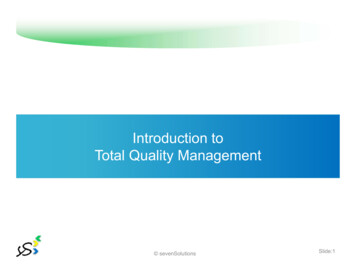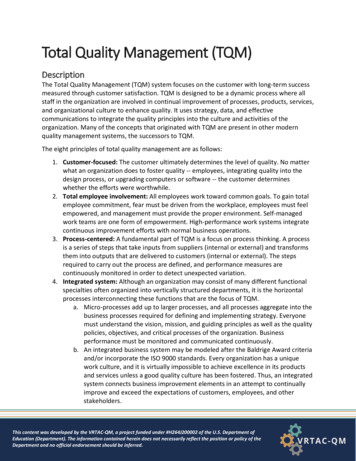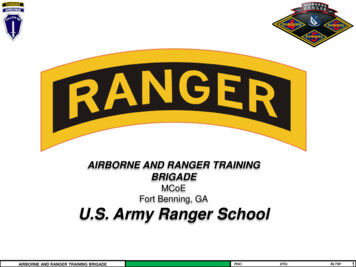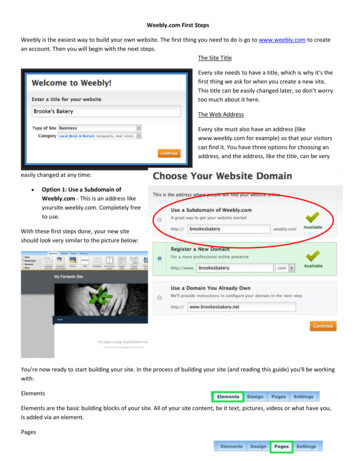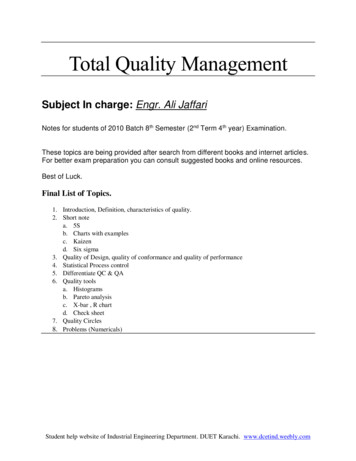
Transcription
Total Quality ManagementSubject In charge: Engr. Ali JaffariNotes for students of 2010 Batch 8th Semester (2nd Term 4th year) Examination.These topics are being provided after search from different books and internet articles.For better exam preparation you can consult suggested books and online resources.Best of Luck.Final List of Topics.1. Introduction, Definition, characteristics of quality.2. Short notea. 5Sb. Charts with examplesc. Kaizend. Six sigma3. Quality of Design, quality of conformance and quality of performance4. Statistical Process control5. Differentiate QC & QA6. Quality toolsa. Histogramsb. Pareto analysisc. X-bar , R chartd. Check sheet7. Quality Circles8. Problems (Numericals)Student help website of Industrial Engineering Department. DUET Karachi. www.dcetind.weebly.com
Quality Assurance vs Quality ControlQuality Assurance is process oriented and focuses on defect prevention; whilequality control is product oriented and focuses on defect identification.Comparison chartQuality AssuranceQA is a set of activities for ensuringquality in the processes by whichDefinitionproducts are developed.QA aims to prevent defects with a focuson the process used to make the product.Focus onIt is a proactive quality process.Quality ControlQC is a set of activities for ensuringquality in products. The activitiesfocus on identifying defects in theactual products produced.QC aims to identify (and correct)defects in the finished product.Quality control, therefore, is areactive process.The goal of QA is to improvedevelopment and test processes so thatGoaldefects do not arise when the product isbeing developed.The goal of QC is to identifydefects after a product is developedand before it's released.Establish a good quality managementsystem and the assessment of itsHowadequacy. Periodic conformance auditsof the operations of the system.Finding & eliminating sources ofquality problems through tools &equipment so that customer'srequirements are continually met.Prevention of quality problems throughWhat planned and systematic activitiesincluding documentation.ResponsibilityExampleEveryone on the team involved indeveloping the product is responsible forquality assurance.Quality control is usually theresponsibility of a specific team thattests the product for defects.Verification is an example of QAValidation/Software Testing is anexample of QCStatistical Tools & Techniques can beapplied in both QA & QC. When theyStatistical are applied to processes (process inputsTechniques & operational parameters), they arecalled Statistical Process Control (SPC);& it becomes the part of QA.As a toolThe activities or techniques used toachieve and maintain the productquality, process and service.QA is a managerial toolWhen statistical tools & techniquesare applied to finished products(process outputs), they are called asStatistical Quality Control (SQC) &comes under QC.QC is a corrective toolStudent help website of Industrial Engineering Department. DUET Karachi. www.dcetind.weebly.com
Differences between Quality Assurance and QualityControlDefinitions of QA and QC Quality Assurance (QA) refers to the process used to create the deliverables,and can be performed by a manager, client, or even a third-party reviewer.Examples of quality assurance include process checklists, project audits andmethodology and standards development.o Quality Control (QC) refers to quality related activities associated with thecreation of project deliverables. Quality control is used to verify that deliverablesare of acceptable quality and that they are complete and correct. Examples ofquality control activities include inspection, deliverable peer reviews and thetesting process. Quality control is about adherence to requirements. Quality assurance is genericand does not concern the specific requirements of the product being developed. Quality assurance activities are determined before production work begins andthese activities are performed while the product is being developed. Incontrast,Quality control activities are performed after the product is developed.oStudent help website of Industrial Engineering Department. DUET Karachi. www.dcetind.weebly.com
4INTRODUCTION TO QUALITY CONTROL AND THE TOTAL QUALITY SYSTEMfor the design and implementation of quality. Of importance will be the ability to identify theunique needs of the customer, which will assist in maintaining and growing market share. Astudy of activity-based product costing will be introduced along with the impact of qualityimprovement on various quality-related costs. The reader should be able to interpret therelationships among quality, productivity, long-term growth, and customer satisfaction.1-2 EVOLUTION OF QUALITY CONTROLThe quality of goods produced and services rendered has been monitored, either directly orindirectly, since time immemorial. However, using a quantitative base involving statisticalprinciples to control quality is a modern concept.The ancient Egyptians demonstrated a commitment to quality in the construction of theirpyramids. The Greeks set high standards in arts and crafts. The quality of Greek architecture ofthe fifth century B.C. was so envied that it profoundly affected the subsequent architecturalconstructions of Rome. Roman-built cities, churches, bridges, and roads inspire us even today.During the Middle Ages and up to the nineteenth century, the production of goods andservices was confined predominantly to a single person or a small group. The groups wereoften family-owned businesses, so the responsibility for controlling the quality of a productor service lay with that person or small group—Those also responsible for producing itemsconforming to those standards. This phase, comprising the time period up to 1900, has beenlabeled by Feigenbaum (1983) the operator quality control period. The entire product wasmanufactured by one person or by a very small group of persons. For this reason, the qualityof the product could essentially be controlled by a person who was also the operator, and thevolume of production was limited. The worker felt a sense of accomplishment, which liftedmorale and motivated the worker to new heights of excellence. Controlling the quality of theproduct was thus embedded in the philosophy of the worker because pride in workmanshipwas widespread.Starting in the early twentieth century and continuing to about 1920, a second phaseevolved, called the foreman quality control period (Feigenbaum 1983). With the IndustrialRevolution came the concept of mass production, which was based on the principle ofspecialization of labor. A person was responsible not for production of an entire product butrather, for only a portion of it. One drawback of this approach was the decrease in the workers'sense of accomplishment and pride in their work. However, most tasks were still not verycomplicated, and workers became skilled at the particular operations that they performed.People who performed similar operations were grouped together. A supervisor who directedthat operation now had the task of ensuring that quality was achieved. Foremen or supervisors controlled the quality of the product, and they were also responsible for operations intheir span of control.The period from about 1920 to 1940 saw the next phase in the evolution of quality control.Feigenbaum (1983) calls this the inspection quality control period. Products and processesbecame more complicated, and production volume increased. As the number of workersreporting to a foreman grew in number, it became impossible for the foreman to keep closewatch over individual operations. Inspectors were therefore designated to check the qualityof a product after certain operations. Standards were set, and inspectors compared the qualityof the item produced against those standards. In the event of discrepancies between astandard and a product, deficient items were set aside from those that met the standard. Thenonconforming items were reworked if feasible, or were discarded.
EVOLUTION OF QUALITY CONTROL5During this period, the foundations of statistical aspects of quality control were beingdeveloped, although they did not gain wide usage in U.S. industry. In 1924, Walter A.Shewhart of Bell Telephone Laboratories proposed the use of statistical charts to control thevariables of a product. These came to be known as control charts (sometimes referred to asShewhart control charts). They play a fundamental role in statistical process control. In thelate 1920s, H. F. Dodge and H. G. Romig, also from Bell Telephone Laboratories, pioneeredwork in the areas of acceptance sampling plans. These plans were to become substitutes for100% inspection.The 1930s saw the application of acceptance sampling plans in industry, both domesticand abroad. Walter Shewhart continued his efforts to promote to industry the fundamentals ofstatistical quality control. In 1929 he obtained the sponsorship of the American Society forTesting and Materials (ASTM), the American Society of Mechanical Engineers (ASME),the American Statistical Association (ASA), and the Institute of Mathematical Statistics(IMS) in creating the Joint Committee for the Development of Statistical Applications inEngineering and Manufacturing.Interest in thefieldof quality control began to gain acceptance in England at this time. TheBritish Standards Institution Standard 600 dealt with applications of statistical methods toindustrial standardization and quality control. In the United States, J. Scanlon introduced theScanlonplan, which dealt with improvement of the overall quality of worklife (Feigenbaum1983). Furthermore, the U.S. Food, Drug, and Cosmetic Act of 1938 had jurisdictionover procedures and practices in the areas of processing, manufacturing, and packing.The next phase in the evolution process, called the statistical quality control phase byFeigenbaum (1983), occurred between 1940 and 1960. Production requirements escalatedduring World War II. Since 100% inspection was often not feasible, the principles of samplingplans gained acceptance. The American Society for Quality Control (ASQC) was formed in1946, subsequently renamed the American Society for Quality (ASQ). A set of samplinginspection plans for attributes called MIL-STD-105Awas developed by the military in 1950.These plans underwent several subsequent modifications, becoming MIL-STD-105B, MILSTD-105C, MIL-STD-105D, and MIL-STD-105E. Furthermore, in 1957, a set of samplingplans for variables called MEL-STD-414 was also developed by the military.Although suffering widespread damage during World War II, Japan embraced thephilosophy of statistical quality control wholeheartedly. When W. Edwards Deming visitedJapan and lectured on these new ideas in 1950, Japanese engineers and top managementbecame convinced of the importance of statistical quality control as a means of gaining acompetitive edge in the world market. J. M. Juran, another pioneer in quality control, visitedJapan in 1954 and further impressed on them the strategic role that management plays in theachievement of a quality program. The Japanese were quick to realize the profound effectsthat these principles would have on the future of business, and they made a strongcommitment to a massive program of training and education.Meanwhile, in the United States, developments in the area of sampling plans weretaking place. In 1958, the Department of Defense (DOD) developed the Quality Controland Reliability Handbook H-107, which dealt with single-level continuous samplingprocedures and tables for inspection by attributes. Revised in 1959, this book became theQuality Control and Reliability Handbook H-108, which also covered multilevel continuous sampling procedures as well as topics in life testing and reliability.The next phase, total quality control, took place during the 1960s (Feigenbaum 1983). Animportant feature during this phase was the gradual involvement of several departments andmanagement personnel in the quality control process. Previously, most of these activities
6INTRODUCTION TO QUALITY CONTROL AND THE TOTAL QUALITY SYSTEMwere dealt with by people on the shop floor, by the production foreman, or by people from theinspection and quality control department. The commonly held attitude prior to this periodwas that quality control was the responsibility of the inspection department. The 1960s,however, saw some changes in this attitude. People began to realize that each department hadan important role to play in the production of a quality item. The concept of zero defects,which centered around achieving productivity through worker involvement, emerged duringthis time. For critical products and assemblies - [e.g., missiles and rockets used in the spaceprogram by the National Aeronautics and Space Administration (NASA)] this conceptproved to be very successful. Along similar lines, the use of quality circles was beginning togrow in Japan. This concept, which is based on the participative style of management,assumes that productivity will improve through an uplift of morale and motivation, achievedin turn, through consultation and discussion in informal subgroups.The advent of the 1970s brought what Feigenbaum (1983) calls the total quality controlorganizationwide phase, which involved the participation of everyone in the company, fromthe operator to the first-line supervisor, manager, vice president, and even the chief executiveofficer. Quality was associated with every person. As this notion continued in the 1980s, itwas termed by Feigenbaum (1983) the total quality system, which he defines as follows: "Aquality system is the agreed on companywide and plantwide operating work structure,documented in effective, integrated technical and managerial procedures, for guiding thecoordinated actions of the people, the machines, and the information of the company andplant in the best and most practical ways to assure customer quality satisfaction andeconomical costs of quality."In Japan, the 1970s marked the expanded use of a graphical tool known as the cause-andeffect diagram. This tool was introduced in 1943 by K. Ishikawa and is sometimes called anIshikawa diagram. It is also called afishbonediagram because of its resemblance to a fishskeleton. This diagram helps identify possible reasons for a process to go out of control aswell as possible effects on the process. It has become an important tool in the use of controlcharts because it aids in choosing the appropriate action to take in the event of a process beingout of control. Also in this decade, G. Taguchi of Japan introduced the concept of qualityimprovement through statistically designed experiments. Expanded use of this technique hascontinued in the 1990s as companies have sought to improve the design phase.In the 1980s, U.S. advertising campaigns placed quality control in the limelight. Consumers were bombarded with advertisements related to product quality, and frequent comparisons were made with those of competitors. These promotional efforts tried to point outcertain product characteristics that were superior to those of similar products. Within theindustry itself, an awareness of the importance of quality was beginning to evolve at alllevels. Top management saw the critical need for the marriage of the quality philosophy to theproduction of goods and services in all phases, starting with the determination of customerneeds and product design and continuing on to product assurance and customer service.As computer use exploded during the 1980s, an abundance of quality control softwareprograms came on the market. The notion of a total quality system increased the emphasison vendor quality control, product design assurance, product and process quality audit,and related areas. Industrial giants such as the Ford Motor Company and General MotorsCorporation adopted the quality philosophy and made strides in the implementation ofstatistical quality control methods. They, in turn, pressured other companies to usequality control techniques. For example, Ford demanded documentation of statisticalprocess control from its vendors. Thus, smaller companies that had not used statisticalquality control methods previously were forced to adopt these methods to maintain their
QUALITY7contracts. The strategic importance of quality control and improvement was formallyrecognized in the United States through the Malcolm Baldrige National Quality Awardin 1987.The emphasis on customer satisfaction and continuous quality improvement globallycreated a need for a system of standards and guidelines that support the quality philosophy.The International Organization for Standardization (ISO) developed a set of standards, ISO9000-9004, in the late 1980s. The American National Standards Institute (ANSI) and ASQCbrought their standards in line with the ISO standards when they developed the ANSI/ASQCQ90-Q94 in 1987, which was subsequently revised in 1994 to ANSI/ASQC Q9000-Q9004,and further in 2000, to ANSI/ISO/ASQ Q9000-2000. The ISO 9000-9004 standards werealso revised in 1994 and 2000.Beginning with the last decade of the twentieth century and continuing on to the currentcentury, the world has seen the evolution of an era of information technology. This is themajor revolution since the Industrial Revolution of the late eighteenth century. The twentyfirst century is undergoing its revolution in information technology digitally, using wirelesstechnology. Such advances promote the maintenace and protection of information qualitywhile delivering data in an effective manner. Further, advances in computational technologyhave made it feasible to solve, in a timely fashion, complex and/or large-scale problems to beused for decision making. Moreover, the Internet is part and parcel of our everyday lives.Among a multitude of uses, we make travel arrangements, purchase items, look upinformation on a variety of topics, and correspond. All of these activities are conductedon a real-time basis, thus raising expectations regarding what constitutes timely completion.On receiving an order through the Internet, service providers will be expected to conduct anerror-free transaction, for example, either assemble the product or provide the service,receive payment, and provide an online tracking system for the customer to monitor. Thus,the current century will continue to experience a thrust in growth of quality assurance andimprovement methods that can, using technology, assimilate data and analyze them in realtime and with no tolerance for errors.1-3 QUALITYThe notion of quality has been defined in different ways by various authors. Garvin (1984)divides the definition of quality into five categories: transcendent, product-based, userbased, manufacturing-based, and value-based. Furthermore, he identifies a framework ofeight attributes that may be used to define quality: performance, features, reliability,conformance, durability, serviceability, aesthetics, and perceived quality. This frequentlyused definition is attributed to Crosby (1979): "Quality is conformance to requirements orspecifications." A more general definition proposed by Juran (1974) is as follows: "Quality isfitness for use."In this book we adopt, the latter definition and expand it to cover both the manufacturingand service sectors. The service sector accounts for a substantial segment of our presenteconomy; it is a major constituent that is not to be neglected. Projections indicate that thisproportion will expand even further in the future. Hence, quality may be defined as follows:The quality of a product or service is the fitness of that product or service for meeting orexceeding its intended use as required by the customer.So, who is the driving force behind determining the level of quality that should be designedinto a product or service? The customer*. Therefore, as the needs of customers change, so
8INTRODUCTION TO QUALITY CONTROL AND THE TOTAL QUALITY SYSTEMshould the level of quality. If, for example, customers prefer an automobile that givesadequate service for 15 years, then that is precisely what the notion of a quality product shouldbe. Quality, in this sense, is not something that is held at a constant universal level. In thisview, the term quality implies different levels of expectations for different groups ofconsumers. For instance, to some, a quality restaurant may be one that provides extraordinarycuisine served on the finest china with an ambience of soft music. However, to another groupof consumers, the characteristics that comprise a quality restaurant may be quite different:excellent food served buffet style at moderate prices until the early morning hours.Quality CharacteristicsThe preceding example demonstrates that one or more elements define the intended qualitylevel of a product or service. These elements, known as quality characteristics, can becategorized in these groupings: Structural characteristics include such elements as thelength of a part, the weight of a can, the strength of a beam, the viscosity of a fluid, and so on;sensory characteristics include the taste of good food, the smell of a sweet fragrance, andthe beauty of a model, among others; time-oriented characteristics include such measuresas a warranty, reliability, and maintainability; and ethical characteristics include honesty,courtesy, friendliness, and so on.Variables and AttributesQuality characteristics fall into two broad classes: variables and attributes. Characteristicsthat are measurable and are expressed on a numerical scale are called variables. The waitingtime in a bank before being served, expressed in minutes, is a variable, as are the density of aliquid in grams per cubic centimeter and the resistance of a coil in ohms.Prior to defining an attribute, we should defined a nonconformity and a nonconformingunit. A nonconformity is a quality characteristic that does not meet its stipulated specifications. Let's say that the specification on the fill volume of soft drink bottles is 750 3milliliters (mL). If we have a bottle containing 745 mL, its fill volume is a nonconformity. Anonconforming unit has one or more nonconformities such that the unit is unable to meet theintended standards and is unable to function as required. An example of a nonconformingunit is a cast iron pipe whose internal diameter and weight both fail to satisfy specifications,thereby making the unit dysfunctional.A quality characteristic is said to be an attribute if it is classified as either conforming ornonconforming to a stipulated specification. A quality characteristic that cannot bemeasured on a numerical scale is expressed as an attribute. For example, the smell of acologne is characterized as either acceptable or is not; the color of a fabric is either acceptableor is not. However, there are some variables that are treated as attributes because it is simplerto measure them this way or because it is difficult to obtain data on them. Examples in thiscategory are numerous. For instance, the diameter of a bearing is, in theory, a variable.However, if we measure the diameter using a go/no-go gage and classify it as eitherconforming or nonconforming (with respect to some established specifications), thecharacteristic is expressed as an attribute. The reasons for using a go/no-go gage, as opposedto a micrometer, could be economic; that is, the time needed to obtain a measurement using ago/no-go gage may be much shorter and consequently less expensive. Alternatively, aninspector may not have enough time to obtain measurements on a numerical scale using amicrometer, so such a classification of variables would not be feasible.
QUALITY9DefectsA defect is associated with a quality characteristic that does not meet certain standards.Furthermore, the severity of one of more defects in a product or service may cause it to beunacceptable (or defective). The modern term fordefectis nonconformity, and the term fordefective is nonconforming item. The American National Standards Institute, the International Organization for Standardization, and the American Society for Quality providea definition of a defect in ANSI/ISO/ASQ Standard A8402 (ASQ 1994).Standard or SpecificationSince the definition of quality involves meeting the requirements of the customer, theserequirements need to be documented. A standard, or a specification, refers to a precisestatement that formalizes the requirements of the customer; it may relate to a product, aprocess, or a service. For example, the specifications for an axle might be 2 0.1 centimeters(cm) for the inside diameter, 4 0.2 cm for the outside diameter, and 10 0.5 cm for thelength. This means that for an axle to be acceptable to the customer, each of these dimensionsmust be within the values specified. Definitions given by the National Bureau of Standards(NBS, 2005) are as follows: Specification: a set of conditions and requirements, of specific and limited application, that provide a detailed description of the procedure, process, material, product, orservice for use primarily in procurement and manufacturing. Standards may bereferenced or included in a specification. Standard: a prescribed set of conditions and requirements, of general or broadapplication, established by authority or agreement, to be satisfied by a material,product, process, procedure, convention, test method; and/or the physical, functional,performance, or conformance characteristic thereof. A physical embodiment of a unitof measurement (for example, an object such as the standard kilogram or an apparatussuch as the cesium beam clock).Acceptable bounds on individual quality characteristics (say, 2 0.1 cm for theinside diameter) are usually known as specification limits, whereas the documentthat addresses the requirements of all the quality characteristics is labeled the standard.Three aspects are usually associated with the definition of quality: quality of design,quality of conformance, and quality of performance.Quality of DesignQuality ofdesign deals with the stringent conditions that a product or service must minimallypossess to satisfy the requirements of the customer. It implies that the product or service mustbe designed to meet at least minimally the needs of the consumer. Generally speaking, thedesign should be the simplest and least expensive while still meeting customer's expectations. Quality of design is influenced by such factors as the type of product, cost, profit policyof the firm, demand for product, availability of parts and materials, and product safety. Forexample, suppose that the quality level of the yield strength of steel cables desired by thecustomer is 100 kg/cm2 (kilograms per square centimeter). When designing such a cable, theparameters that influence the yield strength would be selected so as to satisfy this
10INTRODUCTION TO QUALITY CONTROL AND THE TOTAL QUALITY SYSTEMCostValueabcdDesigned quality levelFIGURE 1-1 Cost and value as a function of designed quality.requirement at least minimally. In practice, the product is typically overdesigned so that thedesired conditions are exceeded. The choice of a safety factor (k) normally accomplishes thispurpose. Thus, to design a product with a 25% stronger load characteristic over the specifiedweight, the value of k would equal 1.25, and the product will be designed for a yield strengthof 100 x 1.25 125 kg/cm2.In most situations, the effect of an increase in the design quality level is to increase the costat an exponential rate. The value of the product, however, increases at a decreasing rate, withthe rate of increase approaching zero beyond a certain designed quality level. Figure 1-1shows the impact of the design quality level on the cost and value of the product or service.Sometimes, it might be of interest to choose a design quality level b, which maximizes thedifferences between value and cost given that the minimal customer requirements a are met.This is done with the idea of maximizing the return on investment. It may be observed fromFigure 1 -1 that for a designed quality level c, the cost and value are equal. For any level abovec (say, d) the cost exceeds the value. This information is important when a suitable designlevel is being chosen.Quality of ConformanceQuality ofconformance implies that a manufactured product ora service rendered must meetthe standards selected in the design phase. With respect to the manufacturing sector, thisphase is concerned with the degree to which quality is controlled from the procurement ofraw material to the shipment of finished goods. It consists of the three broad areas of defectprevention, defect finding, and defect analysis and rectification. As the name suggests,defect prevention deals with the means to deter the occurrence of defects and is usuallyachieved using statistical process control techniques. Locating defects is conducted throughinspection, testing, and statistical analysis of data from the process. Finally, the causesbehind the presence of defects are investigated, and corrective actions are taken.Figure 1-2 shows how quality of design, conformance, and performance influence thequality of a product or service. The quality of design has an impact on the quality ofconformance. Obviously, one must be able to produce what was designed. Thus, if the designspecification for the length of iron pins is 20 0.2 mm (millimeters), the question that mustbe addressed is how to design the tools, equipment, and operations such that the manufactured product will meet the design specifications. If such a system of production can be
QUALITY CONTROL11FIGURE 1-2 The three aspects of quality.achieved, the conformance phase will be capable of meeting the stringent requirements of thedesign phase. On the other hand, if such a production system is not feasibly attained (e.g., ifthe process is only capable of producing pins with a specification of 20 0
called Statistical Process Control (SPC); & it becomes the part of QA. When statistical tools & techniques are applied to finished products (process outputs), they are called as Statistical Quality Contr
